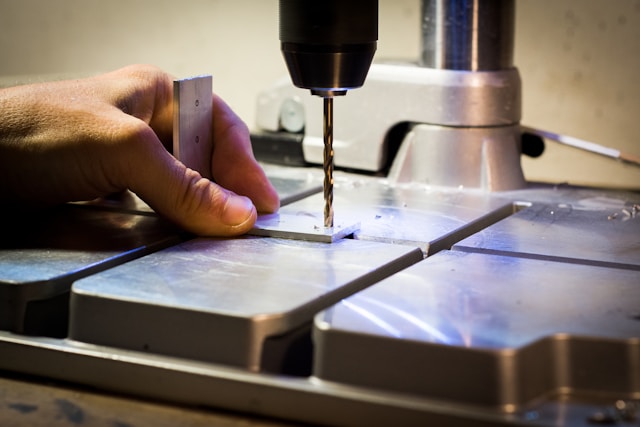7075 vs. 6061 Aluminum Choosing the Right Alloy for Performance

7075 and 6061 aluminum alloys are widely used in various industries, making them a versatile choice for various engineering applications. Still, although both these alloys are similar in some performance aspects, they have enough differences that make them suitable for different applications.
Notably, 7075 Aluminum Alloy was developed in Japan in the 1930s in an effort to make a strong and lightweight material that would replace steel in the aerospace industry. The alloy was first used in the Mitsubishi A6M Zero fighter plane, where it significantly reduced the vessel’s weight while also providing excellent structural rigidity.
Meanwhile, 6061 Aluminum Alloy was developed in 1935 by the Aluminum Association of America. Unlike its counterpart, 6061 was first used in railroad cars and ships, where its excellent corrosion resistance, formability, and weldability increased strength and durability.
Chemical Composition and Properties
7075 and 6061 Aluminum Alloys have unique chemical compositions, which lead to different properties and, ultimately, make them serviceable in different fields.
7075 Aluminum Alloy Characteristics
7075 Aluminum Alloy has a high Zinc content of 5.6-6.1%, along with 2.1-2.5% Magnesium and 1.2-2.0% Copper. Small quantities of Chromium (0.18-0.28%) and Manganese (<0.3%) are also present.
The combination of Al-Zn-Mg-Cu is known to produce excellent tensile strength without the weight penalty. Notably, 7075 Aluminum alloys can have a tensile strength of up to 83,000 psi (572 MPa), making it an excellent replacement for steel in many applications.
This alloy also has good fatigue resistance, though its high strength means lower ductility. Moreover, due to the high percentage of Zinc, 7075 Aluminum Alloy has low corrosion resistance (coatings are a must) and poor weldability.
6061 Aluminum Alloy Characteristics
6061 Aluminum Alloy is a more versatile material, achieved through the use of Magnesium (0.4-0.8%) and Silicon (0.4-0.8%), with trace amounts of copper (up to 0.4%), iron, and Zinc.
As a result, 6061 has exceptional corrosion resistance and reacts well to anodizing, making it suitable for outdoor applications. It is also easily weldable and possesses high formability, though at the expense of a much lower tensile strength of about 45,000 psi (310 MPa).
That said, 6061 Aluminum Alloy reacts well to heat treatments, especially to precipitation hardening, and has good thermal conductivity.
Mechanical and Physical Properties
The mechanical properties of 7075 and 6061 Aluminum Alloys vary dramatically, with both excelling in certain areas.
7075 vs. 6061 – Strength and Durability
7075 Aluminum Alloy is significantly stronger than its 6061 counterparts, as it boasts a high yield and ultimate tensile strength. It is less ductile, though, meaning it could fracture more easily in certain conditions. In other words, 6061 Aluminum Alloy is a better choice for applications where the material undergoes extensive bending or stretching.
7075 vs. 6061 – Corrosion Resistance
6061 Aluminum Alloy is significantly more resistant to corrosion than its 7075 counterpart. That is mainly due to the latter’s high Zinc content and the presence of Magnesium and Silicon in 6061. As such, 6061 Aluminum Alloy is the preferred choice in marine applications and any implementation that requires high corrosion resistance.
7075 vs. 6061 – Thermal Conductivity
6061 Aluminum Alloy is a better choice in applications where efficient heat dissipation is required, like in heat exchangers for road-going vehicles. Strength is not paramount in these parts, so 6061 remains the preferred choice.
7075 vs. 6061 – Weight and Density
7075 Aluminum Alloy is slightly denser than 6061, though its much higher strength minimizes the weight penalty. Besides, both alloys are known for being very lightweight, particularly when compared to steel alloys.
Practical Applications and Performance of 7075 and 6061 Aluminum Alloys
7075 and 6061 Aluminum Alloys are used in a variety of practical applications. Since these alloys have different properties, they are used in different fields, though in many applications, using both these alloys is necessary.
Aerospace and Aviation Uses
7075 Aluminum Alloy is one of the most widely used alloys in aerospace and aviation, thanks to its high strength and low weight. Manufacturers utilize it to produce aircraft wings and fuselages, as well as fittings, gears, and shafts.
However, 6061 Aluminum Alloy is also used for certain parts, particularly those that require higher corrosion resistance and weldability, and in sections that require extensive forming or joining.
Automotive and Transportation
7075 Aluminum Alloy is widely used in automotive applications, particularly for racing and sports car chassis. High strength and weight reduction would result in higher performance and better handling in these vehicles.
That said, 6061 Aluminum Alloy is also extensively used in the automotive industry, though not necessarily for structural parts. Manufacturers mostly utilize this alloy for body panels, frames, and wheels, thanks to the ease of fabrication and high corrosion resistance.
Construction and Structural Applications
7075 Aluminum Alloy is not a very popular material in construction, mainly due to its lower weldability and high cost. Still, it finds use in structures where maximum strength is crucial, like in high-stress parts.
Meanwhile, 6061 Aluminum Alloy is a popular alloy in the construction industry, particularly for building bridge frames and railings. This is due to the alloy’s excellent formability and corrosion resistance, but also good weldability.
In Conclusion, choosing between 7075 and 6061 Aluminum Alloys is not a matter of picking the better material, as both have distinct advantages and disadvantages. Instead, it is all about picking the right material for the job at hand, which requires carefully examining the engineering needs and desired properties.

 Tech Steel & Materials
Tech Steel & Materials
Comments are closed